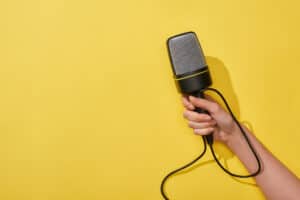Many people love to sing in their cars or in the shower, but with today’s technology, there are ways you can make your voice sound like it belongs on the radio. There are many different types of microphones you can use with your computer. The most common type is a headset microphone (a regular microphone will work as well). You can purchase these microphones at any electronic store or online. You can also make your own microphone stand, which will help you work on your vocals each day.
Take a look below to see how it’s done:
You’ll need:
A paper clip (or coat hanger) A CD Two stick pins Electrical tape A pencil Miniature screwdriver/remote control Making a CD mic stand:
1. Open the mini CD player and take out the tray by pushing down on the silver button in front of it while sliding it out with your finger.
2. Take the tray apart by separating the pieces that form a “U” shape when they are put together.
3. Slide out or cut off one end of two of the CD case ridges.
4. Put the tray back together and put it inside of the CD case so that – when you flip it over – the tray is sticking out on both sides and the open space is in between them.
5. Bend a paper clip so that one end is forming a hook shape and bend it around the outer edge of the tray to hold all three pieces together, then tighten any loose pieces with pliers or wire cutters.
6. Make two holes on either side of your “U” shaped CD player piece using a pencil or stick pin, making sure that they are big enough for a standard size push pin to fit into.
7. Take the stick pins and push them into the holes you made and place a CD under it so it’s standing up.
8. Put two small pieces of tape over the ends of your paper clip that are sticking out to hold them into place, then put electrical tape or washi tape around it to hide or cover up all unsightly seams.
Connecting your mic:
1. Take apart your headset microphone by removing screws on back with a screwdriver, taking out the wire and cord, and turning upside down and pulling off black case (if necessary).
2. Strip one end of wire about 1/4 inch up so you can see bare wire inside of casing
3. Take apart remote control by removing screws on back with a screwdriver, taking out of casing, and turning upside down to remove battery cover.
4. Take apart headphones by removing screws on either side of metal band, repeating step 2 from headset microphone above.
5. Strip the wire on your headphone cord about 1/4 inch up so you can see bare wire inside of the casing.
6. Twist headphone insulation around wire and use electrical or duct tape to secure it together and keep it isolated from other wires and metal parts that will be touching it against your skin while singing (this is also helpful if your cords are long enough to drape over the mic stand).
7. Plug one end of headphone into line-in port on computer, plug other end of headphone into microphone jack/plug.
8. Plug one end of headset microphone wire into line-in port on computer, plug other end of headset microphone wire into headphone jack/plug.
9. Make sure the cords are all the way plugged in and cover with insulation to avoid any pain or discomfort when singing, then take a small piece of electrical tape and wrap it around your cord where you’re going to be holding it while you sing to make sure that no one gets an accidental shock from touching it while singing!
10. If using a regular mic instead of a headset mic: Take apart mic carefully by removing screws on back with a screwdriver, taking out metal band and circuit board inside casing, taking out any cartridge/callibration that is in the way, then taking off black cover.
11. Strip the wire on your cord about 1/4 inch up so you can see bare wire inside of the casing.
12. Twist headphone insulation around wire and use electrical or duct tape to secure it together and keep it isolated from other wires and metal parts that will be touching it against your skin while singing (this is also helpful if your cords are long enough to drape over the mic stand).
13. Plug one end of headphone into line-in port on computer, plug other end of headphone into microphone jack/plug.
14: Plug one end of headset microphone wire into line-in port on computer, plug other end of headset microphone wire into headphone jack/plug.
15: Attach mic to stand and clip your line-in cord to the side so that it doesn’t get in the way, then connect the other end of your line-in cord to hi-hat controller.
16. Make sure all cords are all the way plugged in and cover with insulation to avoid any pain or discomfort when singing, then take a small piece of electrical tape and wrap it around your cord where you’re going to be holding it while you sing to make sure that no one gets an accidental shock from touching it while singing!













